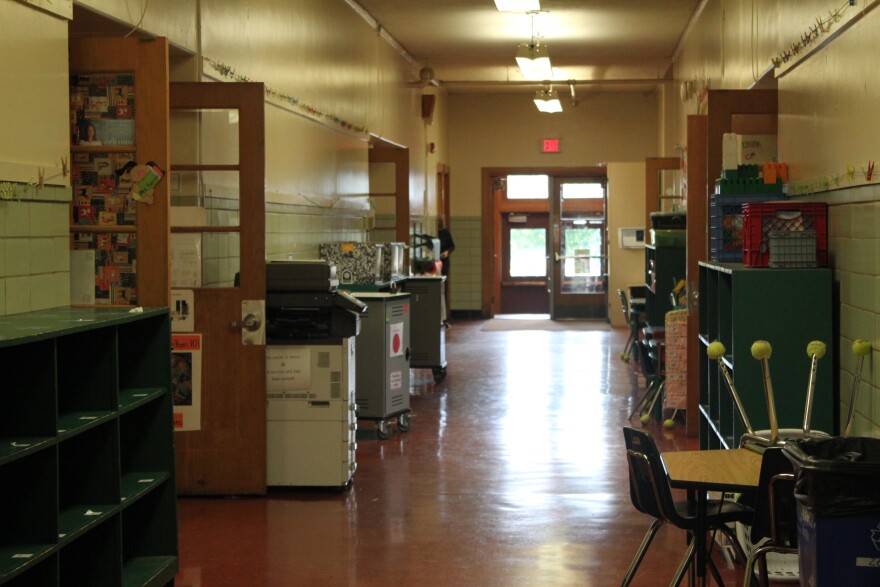Maine’s School Revolving Renovation Fund was established some 20 years ago to help districts face the challenges of fixing aging schools, which have made tough choices due to years of underfunding. But that fund has yet to reach its financial goals, and now has little money left.
This is part two in a two-part series.
Doug Sherwood stops every few feet as he walks through the entrance outside of Longfellow Elementary School in Portland. Sherwood, the district’s facilities coordinator, points to the old, architectural features of the nearly 70-year-old three-story brick building. There’s a carved stone archway, a brick sidewalk and a vestibule decorated with wooden paneling.
“Even though this wood in this vestibule looks tired, it’s unique,” he says. “You want to maintain some of that character.”
But outside the building, the picture isn’t so rosy.
“Look behind all that, and you see crumbling facade around the window frames,” he says. “The masonry work. The windows, though they look in good shape from the outside, you and I looking in, they’re almost 20 years old. They should be replaced. Likewise the roof on top of Longfellow should be replaced.”

The list goes on: the floors contain asbestos, the school lacks elevators and has just one handicap-accessible entrance and, inside, the air is stuffy and humid, with limited ventilation.
To address problems like this in schools across Maine, a commission appointed in 1998 by then-Gov. Angus King recommended that the state provide $200 million over five years to fix Maine’s aging school infrastructure. Lawmakers agreed and created the School Revolving Renovation Fund, a program that provides partially subsidized, no-interest loans for school repairs across Maine.
The goal was to fix those health and safety concerns, and even upgrade science labs and vocational classrooms.
“We got off to a great start. And it had a ginormous impact,” says Maine Department of Education School Facilities Coordinator Scott Brown. “The initiation of that fund, and the money that’s gone through it, if somebody could really quantify the impact it’s had on kids, it’s incredible. Both in terms of air quality, or structural improvements. All over the state.”
RSU 18 Superintendent Carl Gartley says the loans allowed his district in Oakland to renovate roofs, floors and fire systems.

“Our taxpayers are still on the hook for the money,” he says. “But it’s subsidized by the state in a way that makes it affordable.”
Yet, 20 years later, the program has begun to sputter. Due to a lack of continued investment from the Legislature, the state Department of Education says the fund now has less than $3 million remaining. In the latest round of applications, less than half the projects were funded. Without more resources, state officials don’t expect to open a new round of school renovation applications for at least another two years.
Brown says the original goal of the program was to provide $200 million to schools over five years. Yet he says because of a lack of investment, the state has only provided about $176 million over two decades.
“So we have never reached that goal,” he says. “And [the DOE has] supported legislation and testified on numerous occasions and advocated for more money for the fund. It’s really needed.”
In the last legislative session, two bills were put forward to help fund the program but never made it out of the Legislature’s Appropriations Committee. The sponsor of one of the bills, Rep. Richard Farnsworth of Portland, says he plans to continue to advocate for more funding in future sessions.

“At some particular point, we do need to get serious in the discussion at a statewide level, and say, ‘Our public schools are not up to standards. The local schools are scrapped, in terms of what they can afford to fix. The state currently does not have the resources in order to do it,’” he says. “So we need to say, as a state, let’s get serious about this and put some money in the pot in order to make it happen.”
Back in front of Longfellow Elementary School in Portland, district Facilities Director Steven Stilphen says the district has found state funding to be sparse and unreliable in recent years. So it has begun to take on repairs itself.
Two years ago voters passed a $64 million bond to renovate four elementary schools.
“It’s a tough system to work through. To make steady, consistent advancements in your facilities,” Stilphen says.
Meanwhile, the state recently reopened its fund to build new schools in Maine, with projects in Fairfield, Skowhegan and Rumford topping a list of more than 70 applications for building replacements.
Some will be approved. But for the dozens of other districts that are looking for new or renovated schools, the wait continues.
Education reporting on Maine Public Radio is supported by a grant from the Nellie Mae Education Foundation.




